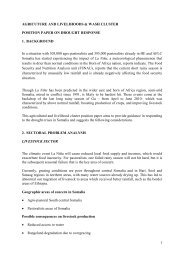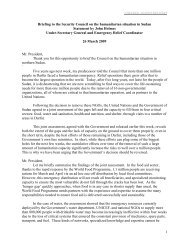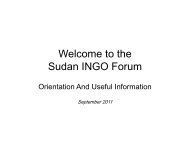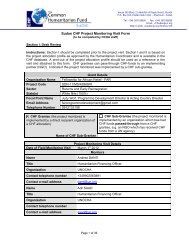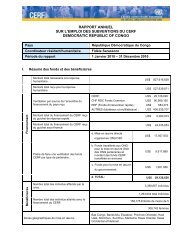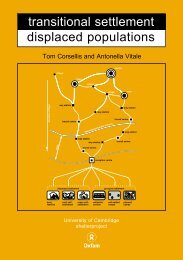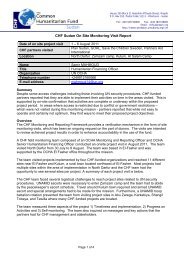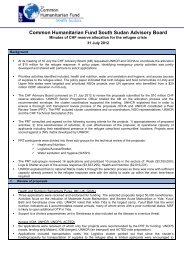Shelter - NFI SPHERE - OCHANet
Shelter - NFI SPHERE - OCHANet
Shelter - NFI SPHERE - OCHANet
Create successful ePaper yourself
Turn your PDF publications into a flip-book with our unique Google optimized e-Paper software.
Minimum Standards in <strong>Shelter</strong>, Settlement and Non-Food Items<br />
Guidance notes<br />
1. Changes of clothing: individuals should have access to sufficient<br />
changes of clothing to ensure their thermal comfort, dignity and safety. This<br />
could entail the provision of more than one set of essential items,<br />
particularly underclothes, to enable laundering.<br />
2. Appropriateness: clothing should be appropriate to climatic conditions<br />
and cultural practices, separately suitable for men, women, girls and boys,<br />
and sized according to age. Bedding materials where possible should reflect<br />
cultural practices and be sufficient in quantity to enable separate sleeping<br />
arrangements as required amongst the members of individual households.<br />
3. Thermal performance: consideration should be given to the insulating<br />
properties of clothing and bedding and the effect of wet or damp climatic<br />
conditions on their thermal performance. An appropriate combination of<br />
clothing and bedding items should be provided to ensure a satisfactory level<br />
of thermal comfort is attained. Provision of insulated sleeping mats to<br />
combat heat loss through the ground may be more effective than providing<br />
additional blankets.<br />
4. Durability: clothing and bedding provided should be sufficiently durable to<br />
accommodate typical wear and likely prolonged usage due to the lack of<br />
alternative items.<br />
5. Special needs: additional changes of clothing should be provided where<br />
possible to people with incontinence problems, people with HIV/AIDS and<br />
associated diarrhoea, pregnant and lactating women, older people,<br />
disabled people and others with impaired mobility. Infants and children are<br />
more prone to heat loss than adults due to their ratio of body surface area<br />
to mass, and may require additional blankets, etc. to maintain appropriate<br />
levels of thermal comfort. Given their lack of mobility, older people and the<br />
ill or infirm, including individuals with HIV/AIDS, may also require particular<br />
attention, such as the provision of mattresses or raised beds.<br />
<strong>Shelter</strong><br />
231




